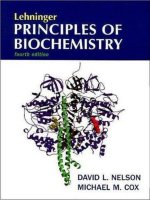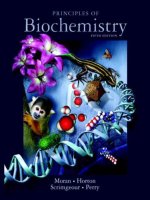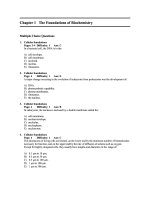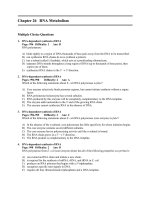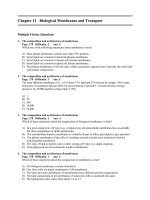kupdf com lehninger principles of biochemistry test bank ch 12pdf
Bạn đang xem bản rút gọn của tài liệu. Xem và tải ngay bản đầy đủ của tài liệu tại đây (192.83 KB, 12 trang )
Chapter 12 Biosignaling
Multiple Choice Questions
1. Molecular mechanisms of signal transduction
Page: 422 Difficulty: 2 Ans: E
Which of the following is not involved in the specificity of signal transduction?
A)
B)
C)
D)
E)
Interactions between receptor and signal molecules
Location of receptor molecules
Structure of receptor molecules
Structure of signal molecules
Transmembrane transport of signal molecules by receptor molecules
2. Molecular mechanisms of signal transduction
Page: 423 Difficulty: 2 Ans: E
Scatchard analysis can provide information on:
A)
B)
C)
D)
E)
enzyme cascades.
enzyme mechanisms.
gated ion channels.
protein phosphorylation.
receptor-ligand interactions.
3. Molecular mechanisms of signal transduction
Page: 425 Difficulty: 1 Ans: B
The force that drives an ion through a membrane channel depends upon:
A)
B)
C)
D)
E)
the charge on the membrane.
the difference in electrical potential across the membrane.
the size of the channel.
the size of the ion.
the size of the membrane.
4. Gated ion channels
Page: 426 Difficulty: 1 Ans: B
The ion channel that opens in response to acetylcholine is an example of a ____________ signal
transduction system.
A)
B)
C)
D)
E)
G protein
ligand-gated
receptor-enzyme
serpentine receptor
voltage-gated
134
Chapter 12 Biosignaling
5. Gated ion channels
Page: 427 Difficulty: 2 Ans: C
The effects of acetylcholine on the postsynaptic ion channel are mainly due to:
A)
B)
C)
D)
E)
cyclic nucleotide synthesis.
protein cleavage (proteolysis).
protein conformational changes.
protein phosphorylation.
protein synthesis.
6. Receptor enzymes
Page: 429 Difficulty: 2 Ans: E
Which of the following statements concerning signal transduction by the insulin receptor is not
correct?
A) Activation of the receptor protein kinase activity results in the activation of additional protein
kinases.
B) Binding of insulin to the receptor activates a protein kinase.
C) Binding of insulin to the receptor results in a change in its quaternary structure.
D) The receptor protein kinase activity is specific for tyrosine residues on the substrate proteins.
E) The substrates of the receptor protein kinase activity are mainly proteins that regulate
transcription.
7. Receptor enzymes
Page: 429 Difficulty: 2 Ans: B
Which of the following statements concerning receptor enzymes is correct?
A)
B)
C)
D)
E)
They are not usually membrane-associated proteins.
They contain an enzyme activity that acts upon a cytosolic substrate.
They contain an enzyme activity that acts upon the extracellular ligand.
They have a ligand-binding site on the cytosolic side of the membrane.
They have an active site on the extracellular side of the membrane.
8. Receptor enzymes
Page: 433 Difficulty: 2 Ans: C
Guanyl cyclase receptor enzymes:
A)
B)
C)
D)
E)
are all membrane-spanning proteins.
are examples of ligand-gated ion channels.
catalyze synthesis of a phosphate ester.
catalyze synthesis of a phosphoric acid anhydride.
require hydrolysis of ATP in addition to GTP.
Chapter 12 Biosignaling
135
9. G protein-coupled receptors and second messengers
Page: 435 Difficulty: 1 Ans: E
Serpentine receptors:
A)
B)
C)
D)
E)
are examples of G (GTP-binding) regulatory proteins.
are mainly involved in the regulation of ion transport.
are present in prokaryotic cells but not in eukaryotic cells.
are present in the nucleus and affect gene expression.
have multiple membrane-spanning helical domains.
10. G protein-coupled receptors and second messengers
Page: 438 Difficulty: 2 Ans: C
Protein kinase A (PKA) is:
A)
B)
C)
D)
E)
activated by covalent binding of cyclic AMP.
affected by cyclic AMP only under unusual circumstances.
allosterically activated by cyclic AMP.
competitively inhibited by cyclic AMP.
noncompetitively inhibited by cyclic AMP.
11. G protein-coupled receptors and second messengers
Page: 439 Difficulty: 2 Ans: C
Which of the following is not involved in signal transduction by the β-adrenergic receptor pathway?
A)
B)
C)
D)
E)
ATP
Cyclic AMP
Cyclic GMP
GTP
All of the above are involved.
12. G protein-coupled receptors and second messengers
Page: 439 Difficulty: 2 Ans: E
Which of the following is not involved in signal transduction by the β-adrenergic receptor pathway?
A)
B)
C)
D)
E)
Cyclic AMP synthesis
GTP hydrolysis
GTP-binding protein
Protein kinase
All of the above are involved.
13. G protein-coupled receptors and second messengers
Page: 441 Difficulty: 2 Ans: C
Which of the following does not involve cyclic AMP?
A)
B)
C)
D)
E)
Regulation of glycogen synthesis and breakdown
Regulation of glycolysis
Signaling by acetylcholine
Signaling by epinephrine
Signaling by glucagon
136
Chapter 12 Biosignaling
14. G Protein-coupled receptors and second messengers
Page: 442 Difficulty: 2 Ans: A
Hormone-activated phospholipase C can convert phosphatidylinositol 4,5-bisphosphate to:
A)
B)
C)
D)
E)
diacylglycerol + inositol triphosphate.
diacylglycerol + inositol+ phosphate.
glycerol + inositol + phosphate.
glycerol + phosphoserine.
phosphatidyl glycerol + inositol + phosphate.
15. G Protein-coupled receptors and second messengers
Page: 444 Difficulty: 2 Ans: E
Calmodulin is a(n):
A)
B)
C)
D)
E)
allosteric activator of calcium-dependent enzymes.
allosteric inhibitor of calcium-dependent enzymes.
calcium-dependent enzyme.
cell surface calcium receptor.
regulatory subunit of calcium-dependent enzymes.
16. Multivalent scaffold proteins and membrane rafts in signaling
Page: 451 Difficulty: 2 Ans: A
The specificity of signaling pathways includes all of the following except:
A)
B)
C)
D)
E)
flippase-catalyzed movement of phospholipids from the inner to the outer leaflet.
migration of signal proteins into membrane rafts.
phosphorylation of target proteins at Ser, Thr, or Tyr residues.
the ability to be switched off instantly by hydrolysis of a single phosphate-ester bond.
the assembly of large multiprotein complexes.
17. Signaling in microorganisms and plants
Page: 453 Difficulty: 2 Ans: D
Which one of the following signaling mechanisms is used most predominantly in plants?
A)
B)
C)
D)
E)
Cyclic-nucleotide dependent protein kinases
DNA-binding nuclear steroid receptors
G protein-coupled receptors
Protein serine/threonine kinases
Protein tyrosine kinases
18. Signaling in microorganisms and plants
Page: 455 Difficulty: 2 Ans: E
In the plant signaling pathways employing receptor-like kinases (RLKs), which one of the following
does not occur?
A)
B)
C)
D)
E)
Activation of a MAPK cascade
Autophosphorylation of receptor
Dimerization of receptor
Ligand binding to receptor
Phosphorylation of key proteins on Tyr residues
Chapter 12 Biosignaling
137
19. Sensory transduction in vision, olfaction, and gustation
Page: 462 Difficulty: 1 Ans: B
Most transduction systems for hormones and sensory stimuli that involve trimeric G proteins have in
common all of the following except:
A)
B)
C)
D)
E)
cyclic nucleotides.
nuclear receptors.
receptors that interact with a G protein.
receptors with multiple transmembrane segments.
self-inactivation.
20. Sensory transduction in vision, olfaction, and gustation
Page: 464 Difficulty: 2 Ans: E
Cholera and pertussis toxins are:
A)
B)
C)
D)
E)
enzyme inhibitors.
enzyme modifiers.
enzymes.
G protein signal transduction disrupters.
all of the above.
21. Regulation of transcription by steroid hormones
Page: 465 Difficulty: 2 Ans: B
Steroid hormones are carried on specific carrier proteins because the hormones:
A)
B)
C)
D)
E)
are too unstable to survive in the blood on their own.
cannot dissolve readily in the blood because they are too hydrophobic.
cannot find their target cells without them.
need them in order to pass through the plasma membrane.
require subsequent binding to specific receptor proteins in the nucleus.
22. Regulation of transcription by steroid hormones
Page: 465 Difficulty: 3 Ans: E
Steriod hormone response elements (HREs) are __________ , which, when bound to
_____________, alter gene expession at the level of ________________.
A)
B)
C)
D)
E)
intron sequences; activated hormone receptor; translation.
nuclear proteins; hormone; transcription.
plasma membrane proteins; hormone; transcription.
sequences in DNA; receptor-hormone complex; replication.
sequences in DNA; receptor-hormone complex; transcription.
23. Regulation of the cell cycle by protein kinases
Page: 467 Difficulty: 2 Ans: A
Which of the following statements concerning cyclin-dependent protein kinases is not correct?
A)
B)
C)
D)
E)
Each type of cell contains one specific form (isozyme).
Their activity fluctuates during the cell cycle.
Their activity is regulated by changes in gene expression, protein phosphorylation, and proteolysis.
Their activity is regulated by cyclins.
They can alter the activity of proteins involved in the progression of cells through the cell cycle.
138
Chapter 12 Biosignaling
24. Regulation of the cell cycle by protein kinases
Page: 467 Difficulty: 2 Ans: D
Which of the following statements concerning cyclins is not correct?
A)
B)
C)
D)
E)
They are activated and degraded during the cell cycle.
They are regulatory subunits for enzymes that catalyze the phosphorylation of proteins.
They can become linked to ubiquitin.
They catalyze the phosphorylation of proteins.
They contain specific amino acid sequences that target them for proteolysis.
25. Regulation of the cell cycle by protein kinases
Page: 469 Difficulty: 2 Ans: E
Ubiquitin is a:
A)
B)
C)
D)
E)
component of the electron transport system.
protease.
protein kinase.
protein phosphorylase.
protein that tags another protein for proteolysis.
26. Regulation of the cell cycle by protein kinases
Page: 470 Difficulty: 2 Ans: C
Cyclin-dependent protein kinases can regulate the progression of cells through the cell cycle by
phosphorylation of proteins such as:
A)
B)
C)
D)
E)
insulin.
myoglobin.
myosin.
retinal rod and cone proteins.
all of the above.
27. Oncogenes, tumor suppressor genes and programmed cell death
Page: 471 Difficulty: 3 Ans: D
Proto-oncogenes can be transformed to oncogenes by all of the following mechanisms except:
A)
B)
C)
D)
E)
chemically induced mutagenesis.
chromosomal rearrangements.
during a viral infection cycle.
elimination of their start signals for translation.
radiation-induced mutation.
28. Oncogenes, tumor suppressor genes and programmed cell death
Pages: 471-472
Difficulty: 3 Ans: B
Oncogenes are known that encode all of the following except:
A)
B)
C)
D)
E)
cytoplasmic G proteins and protein kinases.
DNA-dependent RNA polymerases.
growth factors.
secreted proteins.
transmembrane protein receptors.
Chapter 12 Biosignaling
139
Short Answer Questions
29. Molecular mechanisms of signal transduction
Page: 422 Difficulty: 2
Describe three factors that contribute to the high degree of sensitivity of signal transduction systems.
Ans: The sensitivity of signal transduction results from (a) the high affinity of receptors for signal
molecules; (b) cooperative binding of signal molecules to receptors; (c) signal amplification by
enzyme cascades.
30. Molecular mechanisms of signal transduction
Page: 422 Difficulty: 2
Explain how amplification of a hormonal signal takes place; illustrate with a specific example.
Ans: Amplification occurs when one molecule of signal (epinephrine, for example) elicits the
formation of many molecules of some enzyme (e.g., protein kinase A). This occurs when a single
hormone molecule binds to its specific receptor in the plasma membrane and causes the activation of
several molecules of Gs, each of which activates an enzyme (adenylate cyclase) that, acting
catalytically, produces many molecules of cAMP for every active molecule of enzyme. Each of these
many molecules of cAMP can activate protein kinase A that, acting catalytically, phosphory-lates
many molecules of target protein (e.g., glycogen synthase). (See Fig. 12-16, p. 439.)
31. Molecular mechanisms of signal transduction
Page: 423 Difficulty: 3
What is a Scatchard plot, and how can it be used to determine the number of receptor molecules on a
cell and their affinity for a ligand?
Ans: Cells are mixed with varying concentrations of a ligand and the amount of bound and free
ligand is measured as a function of ligand concentration. A Scatchard plot is a plot of the results as
[bound]/[free] vs. [bound]; in this plot, the x-intercept is a measure of the total number of binding
sites and the slope is a measure of the affinity of the receptor for the ligand.
32. Gated ion channels
Pages: 426-428
Difficulty: 2
Compare and contrast ligand-gated and voltage-gated ion channels; give an example of each.
Ans: Ion channels are protein-based passages in the plasma membrane through which ions can pass.
Gated channels open or close in response to external signals, either specific molecules (ligand-gated)
or changes in transmembrane electrical potential (voltage-gated). An example of a ligand-gated
channel is the acetylcholine receptor; the sodium and potassium channels are examples of voltagegated channels.
33. G Protein-coupled receptors and second messengers
Pages: 430-436
Difficulty: 3
Compare and contrast the modes of action of epinephrine, acting through the β-adrenergic receptor,
and of insulin, acting through the insulin receptor.
Ans: [The mechanisms of epinephrine and insulin action are summarized in Figs. 12-12, p. 436 and
12-6, p. 430]. The adrenergic receptor indirectly activates a catalyst (adenylate cyclase), which
produces a second messenger (cAMP). The insulin receptor is itself a catalyst when occupied with
140
Chapter 12 Biosignaling
insulin; its tyrosine kinase activity phosphorylates and activates another protein kinase, which
initiates a cascade of phosphorylations of other proteins. (See Fig. 12-7, p. 431.)
34. G Protein-coupled receptors and second messengers
Pages: 432-443
Difficulty: 3
Explain how amplification occurs in signal transductions, with examples from two of these systems:
the β-adrenergic receptor, the insulin receptor, or the vasopressin system via inositol-1,4,5trisphosphate (IP3).
Ans: In the β-adrenergic system, amplification is achieved (as is described in Fig. 12-16, p. 439)
when a single hormone molecule binds to a single adrenergic receptor that activates a number of Gs
molecules, each of which activates an enzyme (adenylate cyclase) that catalyzes the formation of
many second messenger molecules (cAMP). In the insulin receptor system, a single molecule of
insulin binds to a receptor, activating its protein tyrosine kinase activity, which acts catalytically to
alter the activity of many target proteins by phosphorylation. (See Fig. 12-8, p. 432.) The IP3 system
(Fig. 12-19, p. 443) also employs a G protein that is activated catalytically by an occupied receptor,
and then activates a second catalyst (phospholipase C). The product of phospholipase C, IP3, releases
sequestered Ca2+ from the endoplasmic reticulum. The Ca2+ activates another catalyst, protein kinase
C. In short, amplification occurs when a single molecule of signal activates a cascade of catalysts.
35. Receptor enzymes
Page: 433 Difficulty: 3
Explain how the cytokine erythropoetin activates transcription of specific genes essential in blood
maturation.
Ans: Binding of erythropoetin to its plasma membrane receptor causes the receptor to dimerize. The
soluble cytoplasmic protein kinase JAK can now bind to receptor, become activated, and
phosphorylate three tyrosine residues on the receptor, some of which in turn are bound by the STAT5
transcription factor, positioning it for phosphorylation by JAK. The phosphorylated STAT5 then
dimerizes, facilitating its transport into the nucleus, where it activates transcription of specific genes
essential in blood maturation.
36. G Protein-coupled receptors and second messengers
Pages: 435-445
Difficulty: 3
Signals carried by hormones must eventually be terminated; the response continues for a limited time.
Discuss three different mechanisms for signal termination, using specific systems as examples.
Ans: Hormonal responses may be terminated by removal of the second messenger (degradation of
cAMP, resequestration of Ca2+); by dephosphorylation of the target protein (by phosphoprotein
phosphatases); or by self-inactivation of G proteins (by hydrolysis of bound GTP to GDP). If the
hormonal stimulus is present for extended periods, desensitization of the hormone receptor (e.g., by
phosphorylation) makes the system unresponsive to the hormone.
37. G Protein-coupled receptors and second messengers
Pages: 436-443
Difficulty: 3
GTP-binding proteins play critical roles in many signal transductions. Describe two cases in which
such proteins act, and compare the role of the G proteins in each case.
Ans: GTP-binding proteins are self-inactivating switches; when a hormonal or other signal activates
the G protein, GTP replaces bound GDP, changing the activity of the G protein. These active G
Chapter 12 Biosignaling
141
proteins then act on the next element in the signaling cascade. In the case of the β-adrenergic
receptor, Gs activates adenylate cyclase; in the IP3 pathways, Gp activates the phospholipase that
generates the second messengers diacylglycerol and IP3. (See Figs. 12-12, p. 436, and 12-19, p. 443.)
38. G Protein-coupled receptors and second messengers
Page: 439 Difficulty: 3
Describe the sequence of biochemical events between the release of epinephrine into the bloodstream
and the activation of the enzyme glycogen phosphorylase.
Ans: Epinephrine binds to its specific receptor on the cell surface. The occupied receptor causes GTP
for GDP exchange on a GTP-binding protein (Gs); Gs then activates adenylate cyclase of the plasma
membrane, which catalyzes production of 3',5'-cyclic AMP (cAMP). The cAMP-dependent protein
kinase (protein kinase A) is activated by the resulting rise in cAMP, and it phosphorylates the enzyme
phosphorylase kinase, activating it. Active phosphorylase kinase phosphorylates glycogen
phosphorylase, activating it and stimulating glycogen breakdown. (See Fig. 12-16, p. 439.)
39. G Protein-coupled receptors and second messengers
Page: 444 Difficulty: 3
Explain how an increase in cytosolic Ca2+ concentration from 10-8 M to 10-6 M activates a Ca2+ and
calmodulin-dependent enzyme.
Ans: The higher Ca2+ concentration allows Ca2+ binding to the four binding sites on the protein
calmodulin. As a consequence of Ca2+ binding, calmodulin undergoes a conformational change that
allows it to interact productively with the enzyme that it activates; the Ca2+-calmodulin enzyme
association activates the enzyme. Also, calmodulin is a subunit of a Ca2+/calmodulin-dependent
protein kinase. The Ca2+-induced conformational change activates the kinase that in turn regulates
the activity of a number of enzymes.
40. Multivalent scaffold proteins and membrane rafts
Page: 448 Difficulty: 2
What is meant by multivalent scaffold proteins in signaling pathways?
Ans: The reversible phosphorylation (at Ser, Thr, or Tyr) of some signaling proteins creates docking
sites for other proteins, and in many cases the interactions between several different such proteins
creates multiprotein signaling complexes.
41. Multivalent scaffold proteins and membrane rafts
Page: 451 Difficulty: 2
Explain the importance of membrane rafts in cell signaling pathways.
Ans: Rafts are membrane regions enriched in sphingolipids and sterols, which can sequester certain
signaling proteins (usually ones from the same pathway), increasing the probability of productive
interactions between them.
42. Signaling in microorganisms and plants
Page: 452 Difficulty: 2
What is meant by the two-component system of bacterial cell signaling?
Ans: The two-component system drives bacterial chemotaxis by coupling autophosphorylation of the
receptor His kinase in response to attractant binding, to phosphorylation of the response regulator
142
Chapter 12 Biosignaling
protein, which in turn controls the direction of flagellar rotation.
43. Signaling in microorganisms and plants
Page: 454 Difficulty: 2
Briefly describe the ethylene detection system of plants.
Ans: In Arabidopsis, the CTR-1 Ser/Thr protein kinase is inactivated by ethylene, which allows
activation of a MAPK cascade that leads to EIN1 activation; this transcription factor stimulates, in
turn, synthesis of ERF1, another transcription factor that stimulates transcription of several ethyleneresponsive genes.
44. Sensory transduction in vision, olfaction, and gustation
Page: 459 Difficulty: 2
How do ligand-gated ion channels play a role in sensory transduction in the eye?
Ans: Rod and cone cells in the retina contain rhodopsin with a light-absorbing pigment. Absorbed
photons cause a change in conformation that ultimately results in a decrease in the concentration of
cyclic GMP, which causes Na+- and Ca2+-gated ion channels to close. This leads to hyperpolarization
of the cell membrane and initiates an electrical signal that travels to the brain.
45. Sensory transduction in vision, olfaction, and gustation
Page: 460 Difficulty: 2
Describe the role of G proteins in olfactory sensory transduction
Ans: When a sensory stimulant interacts with its receptor it triggers a conformational change that
results in displacement of bound GDP by GTP on a G protein. This activated G protein then activates
either adenylyl cyclase or phospholipase C, which in turn increases the level of ligands that open ion
channels.
46. Sensory transduction in vision, olfaction, and gustation
Page: 464 Difficulty: 3
The toxins produced by Bordetella pertussis (which causes whooping cough) and by Vibrio cholerae
(which causes cholera) have similar modes of action in toxin-sensitive mammalian cells. Describe
the molecular basis for their toxic effects.
Ans: Both toxins are enzymes that catalyze the ADP-ribosylation of Gs and Gi proteins that act in
various signal transductions. Attachment of the ADP-ribose moiety prevents the G proteins from
cycling between their GDP-bound and GTP-bound forms, interfering with normal signal
transductions and with metabolic events dependent on the signaling systems.
47. Regulation of transcription by steroid hormones
Page: 465 Difficulty: 1
What is the mechanism of action of the drug tamoxifen in the treatment of breast cancer?
Ans: Tamoxifen is an antagonist of estrogen, and competes with it for binding to the estrogen
receptor. Unlike the situation with estrogen, the tamoxifen-receptor complex, though stable, cannot
elicit significant changes in gene expression, thus slowing the growth of hormone-dependent
cancerous cells.
Chapter 12 Biosignaling
143
48. Regulation of transcription by steroid hormones
Page: 466 Difficulty: 2
Describe two examples of steroid hormone action that occur too rapidly to be the consequence of
altered levels of protein synthesis.
Ans: Progesterone can cause a rapid decrease in cellular cAMP levels, probably via a hormonesensitive membrane protein that mediates the inhibition of adenylyl cyclase. Progesterone can also
quickly activate the MAPK cascade via the soluble progesterone receptor (the mechanism of this
action is not yet clear).
49. Regulation of cell cycle by protein kinases
Pages: 467-470
Difficulty: 2
What are cyclins? What is their role in the regulation of the cell cycle?
Ans: Cyclins are regulatory subunits of protein kinases. The presence of the cyclin subunits is
essential for activation of the protein kinase activity. The levels of cyclins fluctuate during the cell
cycle and in response to cellular and extracellular signals. These changes result in changes in the
activities of the cyclin-dependent protein kinases that in turn regulate and control the cell cycle.
50. Oncogenes, tumor suppressor genes and programmed cell death
Pages: 471-472
Difficulty: 3
Describe the relationship between a proto-oncogene and an oncogene, and explain how one arises
from the other. Explain how a mutation in the EGF receptor, or in a GTP-binding protein, can lead to
unregulated cell division.
Ans: A proto-oncogene is a gene that encodes a normal cellular protein that is involved in some
regulatory process. Mutation in the normal gene creates an oncogene that encodes a defective
regulatory protein. The result is defective regulation of such processes as DNA replication and cell
division, which is characteristic of tumor cells. The normal EGF receptor signals a cell to divide only
when its ligand, epidermal growth factor (EGF), is present. Mutation truncates the EGF receptor,
removing the part that responds to EGF, and creating a “receptor” that constantly sends the signal to
divide. Similarly, when a normal G protein suffers a mutation that destroys its GTPase activity, it can
no longer inactivate itself by converting bound GTP to GDP. Thus, the mutant G protein is always in
its activated form and it continues to send a signal to the cell to divide. (See Fig. 12-48, p. 472.)
51. Oncogenes, tumor suppressor genes and programmed cell death
Pages: 471-473
Difficulty: 3
Explain why mutations in oncogenes are generally dominant while those in tumor suppressor genes
are recessive.
Ans: With oncogenes, the abnormal protein product directly interferes with normal regulation of cell
growth, overriding these functions. By contrast, tumor suppressor proteins normally restrain cell
division, and both chromosomal copies have to be inactivated for growth to become unregulated, thus
a mutation in only one copy does not exhibit the cancerous phenotype.
52. Oncogenes, tumor suppressor genes and programmed cell death
Page: 472 Difficulty: 3
The product of the erbB oncogene closely resembles the cellular receptor for epidermal growth factor
(EGF). How do the two proteins differ, and how does this difference account for the oncogenic
action of the ErbB protein?
144
Chapter 12 Biosignaling
Ans: The EGF receptor is a transmembrane receptor with tyrosine kinase activity that is stimulated by
EGF bound to the extracellular domain of the protein. The ErbB protein is a truncated version of the
EGF receptor, in which the tyrosine kinase activity is always active, even in the absence of EGF,
because the protein lacks the EGF-binding domain. The kinase activity gives the cell the signal for
continuous growth and cell division, producing the unregulated growth that characterizes tumors.
(See Fig. 12-48, p. 472.)
53. Oncogenes, tumor suppressor genes and programmed cell death
Pages: 447,472
Difficulty: 3
Explain how mutations in the following proteins might result in either loss of responsiveness to a
given hormone or production of a continuous signal even in the absence of the hormone: (a) a
mutation in the regulatory (R) subunit of cAMP-dependent protein kinase, making R incapable of
binding to the catalytic (C) subunit; (b) a mutation in a growth factor receptor with protein kinase
activity; (c) a defect in a G protein that renders the GTPase activity inactive.
Ans: (a) When a mutation in the R subunit of cAMP-dependent protein kinase prevents R-C
interaction, the inhibitory effect of R is lost, and the catalytic subunit continues to phosphorylate
target proteins regardless of cAMP concentration. (b) A mutation in a receptor that acts via tyrosine
kinase (the EGF receptor, for example) may lead to production of a receptor molecule in which
tyrosine kinase is always active, even in the absence of the growth factor. (c) When a mutation in a G
protein destroys its GTPase activity, it can no longer inactivate itself by converting bound GTP to
GDP. Once activated, the mutant G protein continues to send its unregulated signal.
